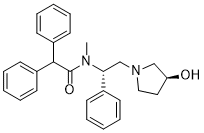| Cas No.: | 153205-46-0 |
| Chemical Name: | Benzeneacetamide,N-[(1S)-2-[(3S)-3-hydroxy-1-pyrrolidinyl]-1-phenylethyl]-N-methyl-a-phenyl- |
| Synonyms: | Benzeneacetamide,N-[(1S)-2-[(3S)-3-hydroxy-1-pyrrolidinyl]-1-phenylethyl]-N-methyl-a-phenyl-;C27H30N2O2;N-[(1S)-2-[(3S)-3-hydroxypyrrolidin-1-yl]-1-phenylethyl]-N-methyl-2,2-diphenylacetamide;Asimadoline;UNII-D0VK52NV5M;N-[(1S)-2-[(3S)-3-Hydroxy-1-pyrrolidinyl]-1-phenylethyl]-N-methyl-alpha-phenylbenzeneacetamide;EMD 61753 |
| SMILES: | O=C(N([C@@H](C1=CC=CC=C1)CN2C[C@@H](O)CC2)C)C(C3=CC=CC=C3)C4=CC=CC=C4 |
| Formula: | C27H30N2O2 |
| M.Wt: | 414.5393 |
| Purity: | >98% |
| Sotrage: | 2 years -20°C Powder, 2 weeks 4°C in DMSO, 6 months -80°C in DMSO |
| Description: | Asimadoline is a potent κ opioid receptor agonist with IC50s of 5.6 and 1.2 nM for guinea pig and human recombinant κ opioid receptor, respectively. |
| In Vivo: | The absorption rate following oral administration is 80% in rats and >90% in dogs and monkeys. The metabolism of Asimadoline is rapid and appears similar in animals and man. Asimadoline has peripheral anti-inflammatory actions that are partly mediated through increase in joint fluid substance P levels[1]. Treatment with Asimadoline (5 mg/kg/day i.p.) produces marked (and sustained) attenuation of the disease with all three time regimes[2]. |
| In Vitro: | The IC50 for Asimadoline binding to μ-opioid receptors is 3 µM and to δ-opioid receptors is 0.7 µM. The IC50 values for D1, D2, kainate, σ, PCP/NMDA, H1, α1, α2, M1/M2, glycine, 5HT1A, 5HT1C, 5HT1D, 5HT2, 5HT3, AMPA and kainate/AMPA receptors are all >10 IC50, suggesting no relevant antihistaminergic, antiserotonergic or anticholinergic effects. At high concentrations, Asimadoline demonstrates spasmolytic action against 400 µM barium chloride in the rat duodenum (IC50=4.2 µM), suggesting that Asimadoline may block the direct stimulant effects of barium on smooth muscle through mechanisms that are not identified[1]. |






















